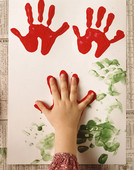
TUESDAY, Aug. 27 (HealthDay News) — When free to choose, kids with autism pick games that engage their senses and avoid games that ask them to pretend, a new study finds.
Experts said the results are not surprising. It’s known, for instance, that when children do not show an interest in pretend play, such as “feeding” a doll, by about age 2, that is a potential sign of an autism spectrum disorder.
What is unique about the new study is that it went out into the real world, said lead researcher Kathy Ralabate Doody, an assistant professor of exceptional education at the State University of New York, Buffalo State.
Doody’s team spent six months observing children who attended a local museum’s Au-some Evenings, a monthly program designed for children with autism. The program offered 20 exhibits with different activities, including a train that children could climb on, arts and crafts and a make-believe farm where kids could pretend to pick vegetables and collect eggs.
The researchers found that children with autism were naturally drawn to activities that got them moving, or allowed them to watch moving objects. The biggest crowd pleaser was an exhibit in which kids climbed a short staircase and dropped a ball into a track to watch it travel over hills. Another favorite was a windmill that the children could spin.
On the other hand, arts and crafts, and exhibits that required pretending were the least popular, according to the findings, which were reported in a recent issue of the North American Journal of Medicine and Science.
“We know that kids on the spectrum have a fascination with things that move, and with repetition,” Doody said.
In contrast, she said, pretend play requires “putting yourself in someone’s shoes,” and talking and acting as if you were another person. That’s an ability with which children with autism spectrum disorders struggle.
The current findings are what you would expect, said Dana Levy, a clinical assistant professor of child and adolescent psychiatry at NYU Langone Medical Center, in New York City.
“I think it’s a really nice idea,” Levy said, referring to the museum’s autism spectrum disorders program.
“We do know that kids with autism are able to practice social skills when they’re doing something they enjoy,” Levy said. So if an activity gets your child around other kids — and talking or learning to take turns, for instance — it could benefit his or her development.
“If it becomes just a solitary thing, though, it’s not really helpful,” Levy said.
Plus, letting children do only the things they’re innately drawn to can be limiting. When young children with autism spectrum disorders are in therapy, pretend play is typically part of it, Levy said.
But if there is a social setting with activities a child with autism enjoys, parents can use that as a door, Levy said. If your child loves the museum’s stair-climbing exhibit, on your next visit tell him or her that you’re going to try one new thing first and then go to the stairs, Levy suggested.
It’s estimated that about one in 88 children has an autism spectrum disorder — a group of developmental disorders that hinder a person’s ability to communicate and interact socially. Autism spectrum disorders range widely in severity: Some children speak very little and have an intense preoccupation with just a few things, while other kids have normal or above-normal intelligence and milder problems with socializing.
For the current study, Doody’s team watched children during six Au-some Evenings events. An average of 31 children with autism spectrum disorders and 22 without (usually siblings) attended each night. One limitation of the research, Doody said, is that they had no medical information on the children, including the severity of their autism.
Doody, who has a child with an autism spectrum disorder, said it would be helpful if more public places had events like this, since parents can struggle to find activities the whole family enjoys — particularly if they also have kids without autism.
She said the current findings could help community programs develop inclusive activities so kids with autism have more chances to interact with typically developing children.
“Being in a social environment is great for them,” Levy said.
Even if your local museum doesn’t have a special program, she said, it might have something that would appeal to your child. If he or she likes to look at maps, for instance, a museum or park that has maps scattered throughout might be a good place to start.
More information
Autism Speaks offers resources and advice for families.
Copyright © 2025 HealthDay. All rights reserved.

